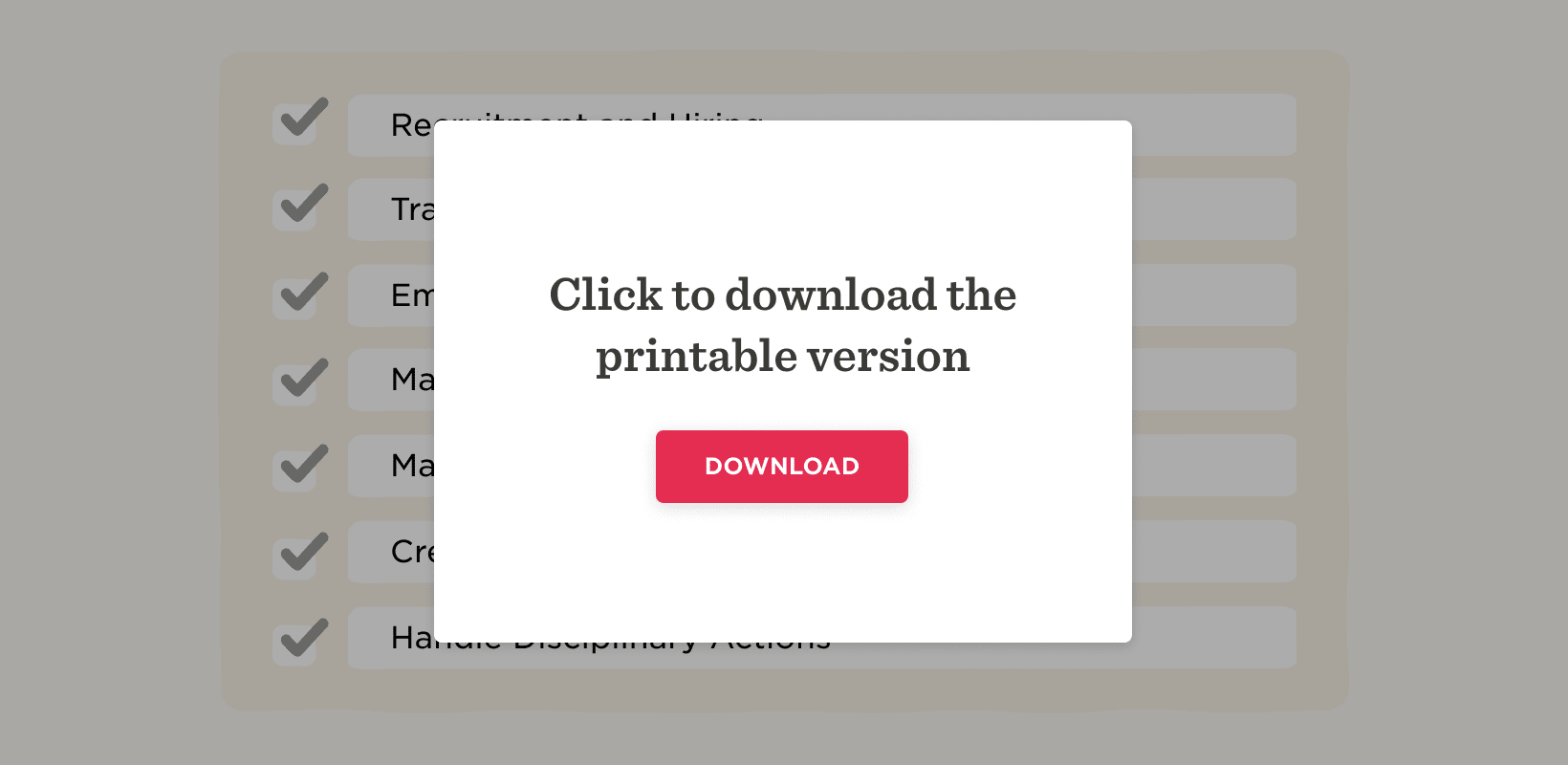HR leaders shape company culture by driving engagement, growth, and accountability. A key part of this is setting clear expectations and addressing challenges—including formal write-ups when needed. In fact, companies with transparent, consistent disciplinary processes see 20 percent higher retention.
A structured approach ensures fairness, strengthens communication, and supports professional growth. With a clear, standardized write-up template, HR teams can document incidents confidently while keeping expectations transparent for everyone.
<<Download our free employee write-up form template.>>
What is an employee write-up form?
An employee write-up form is a formal record HR leaders use to document workplace incidents, policy violations, or performance concerns. It provides a clear account of the issue and outlines next steps for improvement. A well-structured write-up form protects both the company and its people by creating a reference point for future decisions. It also helps track patterns and supports effective performance management.
Why do HR teams use employee write-up forms?
Employee write-ups serve multiple purposes, from maintaining workplace standards to protecting against legal risks. HR teams typically implement them to:
- Create a clear record of workplace issues: Instead of relying on memory or verbal warnings, managers can log incidents in detail so people receive fair and documented feedback
- Encourage accountability: If a team member repeatedly arrives late, a write-up helps leaders track patterns and formalize expectations so they understand what needs to change
- Protect against legal risks: In cases of wrongful termination claims, a well-documented write-up history reduces the risk of legal disputes
- Improve performance management: HR teams can track improvement over time, noting whether someone responds positively to feedback or requires additional coaching.
- Standardize disciplinary processes: A structured write-up process ensures every team member receives the same level of documentation and opportunity to improve
Without clear guidelines, one person might get a formal written warning for a minor issue, while another receives multiple verbal warnings for repeated problems. Standardizing when to give a write-up ensures fairness and removes bias, giving every team member a consistent opportunity to improve.
<<Set clear expectations with our free employee write-up form template.>>
When to use employee write-up forms
While not every issue requires formal documentation, write-ups are essential when verbal feedback isn’t enough to drive improvement. They create a record of concerns, provide a path for correction, and ensure fairness across the organization. HR teams typically issue write-ups for:
- Policy violations: Misusing company resources, violating confidentiality agreements, or failing to follow safety protocols
- Repeated performance issues: Missing deadlines, producing low-quality work, or failing to meet job expectations despite previous feedback
- Chronic attendance problems: Frequent tardiness, unapproved absences, or leaving shifts early without notice
- Workplace misconduct: Engaging in harassment, discrimination, or inappropriate workplace behavior that goes against company values
- Failure to follow manager feedback: Ignoring coaching, resisting constructive criticism, or repeating the same mistakes despite previous discussions
- Conflict with coworkers: Ongoing disruptive behavior, verbal altercations, or creating a hostile work environment
When not to write up an employee
Not every workplace issue calls for a formal write-up. Instead, managers can utilize conversations, training, and coaching to guide people toward improvement. For example, if someone misses a meeting or forgets a minor task, a quick conversation could resolve the issue. A simple misunderstanding or lack of clarity around expectations doesn’t necessarily warrant formal documentation—especially if it’s the first time.
Recognizing the difference between a pattern of concerning behavior and a one-time mistake helps create an environment where people can learn and grow without fear of unnecessary punishment.
Key components of an employee write-up form
Include the following key elements to accurately track workplace incidents and set clear expectations for everyone involved:
Team member information
Start with basic details like the person’s name, job title, department, and direct manager. HR teams can use this information to track disciplinary records in the future.
Incident description
Outline what happened, when it occurred, and any relevant policy violations. Include dates, specific details, and prior discussions or write-ups if applicable. Vague descriptions create room for misinterpretation, so sticking to objective facts helps managers and HR teams address the issue fairly.
Team member explanation
Provide space for the team member to share their side of the story. Sometimes, underlying factors like miscommunication, lack of training, or external challenges contribute to workplace issues. A written response allows the person to clarify details and feel heard.
Consequences of behavior
Clearly define the next steps, whether it’s a performance improvement plan, a final warning, or other disciplinary action. Discussing expectations and consequences eliminates confusion and helps people understand how to correct their actions moving forward.
<<Ensure fairness and consistency with a free employee write-up template.>>
Employee write-up form template
Use this template to easily address workplace incidents, set clear expectations, and document important details:
Full name: _______________________
Job title and department: _______________________
Manager name: _______________________
Date of write-up: ____ / ____ / ____
Date of incident: ____ / ____ / ____
Time of incident (if applicable): _______________________
Description of incident: (Provide specific details, including any policy violations or previous warnings)
Employee comments: (Allow the team member to explain their perspective)
Next steps/expectations: (Specify any disciplinary action, such as a warning, performance plan, or further training)
By signing below, I acknowledge that I have read and understood this write-up.
Employee signature: _______________________ Date: ____ / ____ / ____
Manager signature: _______________________ Date: ____ / ____ / ____
Employee write-up form example
Full name: John Doe
Job title and department: Customer support representative, Customer experience
Manager’s name: Mary Smith
Date of write-up: March 5, 2025
Date of incident: March 3, 2025
Time of incident: 2:15 PM
Description of incident: On March 3rd, John Doe was reported by a customer for using unprofessional language during a support call. The customer escalated the complaint, stating that John’s response was dismissive and did not align with company service standards. John received a verbal warning for a similar issue on February 10th, emphasizing the importance of professional communication in all interactions.
Employee comments: John explained that he was feeling overwhelmed due to high call volume that day and did not intend to come across as dismissive. He acknowledged the impact of his response and is willing to undergo additional customer service training.
Next steps/expectations: John will complete an additional customer service training session by March 15th. His manager will conduct a follow-up review in 30 days to assess progress.
Future incidents of unprofessional communication may result in further disciplinary action, up to and including termination.
By signing below, I acknowledge that I have read and understood this write-up.
Employee signature: _______________________ Date: ____ / ____ / ____
Manager signature: _______________________ Date: ____ / ____ / ____
<<Keep documentation consistent with a free employee write-up template.>>
Best practices for creating an employee write-up
Getting your write-up perfect the first time demonstrates transparency and professionalism. Follow these best practices to create an effective and legally sound write-up.
Work with a consistent format
Use a clear, repeatable format to make it easier to track patterns, follow up, and maintain compliance. Instead of relying on informal emails or verbal warnings, write-up templates make sure every incident gets documented thoroughly.
Use clear language focused on the behavior
Stick to clear, objective facts rather than subjective opinions. Avoid emotionally charged language and focus on what happened, not personal interpretations. For example, instead of “John was disrespectful for being late,” try: “John arrived 20 minutes late on three separate occasions within the past two weeks, exceeding the company’s five-minute grace period.”
Prioritize legality and compliance
HR write-ups must comply with labor laws and company policies to avoid potential legal risks. Ensure that they avoid discrimination based on race, gender, disability, or any other protected category. Only involve key personnel directly related to the situation—HR, direct manager, and legal counsel if needed. Public discussions or sharing sensitive details beyond those involved opens everyone up to unwanted legal and social issues.
Keeping documentation private maintains professionalism and builds trust by showing that organizations handle concerns with respect.
Store the form for follow-ups
Once a write-up is completed, securely store it in the team member’s file within your HR software system. Keeping these records organized ensures transparency and consistency while providing a clear reference for future performance evaluations, promotions, or disciplinary actions.
Secure digital storage also helps managers track patterns over time, ensuring fair and informed decision-making. In the event of legal disputes or audits, having well-documented records protects both the company and its people by showing a clear history of communication and corrective action.
Use employee write-up form templates to document and improve workplace performance
Employee write-ups do more than simply address issues. A well-documented write-up clarifies expectations, ensures fair handling of performance concerns, and provides people with a straightforward path toward improvement.
HR teams can use these templates to track recurring challenges, support managers in difficult conversations, and create a workplace culture rooted in transparency and continuous development.
<<Streamline documentation with this free employee write-up template.>>
Employee write-up form FAQs
Why should you use an employee write-up form template?
A structured template makes every write-up consistent, fair, and legally sound. Using a pre-made write-up form helps HR teams:
- Protect against legal risks
- Document incidents thoroughly
- Make follow-ups easier
- Provide team members with a roadmap for improvement
- Standardize performance and behavioral plans across teams
Recommended For Further Reading
How do you write an employee write-up?
Follow these steps to keep write-ups professional, objective, and actionable:
- Describe the issue clearly: Detail what happened, when it occurred, and how it impacted the team or company
- Explain why the issue matters: Clarify why the behavior needs addressing and how it affects performance, workplace culture, or compliance
- Give the team member a chance to respond: Include their perspective for fairness and document any relevant context they provide
- Define any consequences or corrective actions: Outline next steps with a performance improvement plan, additional required training, or conditions for another warning
- Ask them to sign the document: Confirm they received and understood the write-up, even if they don’t agree with it
Does a write-up mean termination?
A write-up functions as a formal record of a workplace concern, not an automatic termination notice. Most organizations use write-ups as part of a progressive discipline process, which allows people to correct behaviors before facing more serious consequences.
However, repeated write-ups may lead to further disciplinary actions, including letting people go respectfully.

